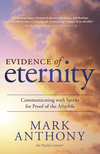Dispelling the Superstition and Fear of Communicating with Our Loved Ones in Spirit

Are you superstitious? Many people are. You may be superstitious without even realizing it. Think about your own personal habits; do you have a "good luck charm?" Maybe it's a rabbit's foot, a shiny penny, or a photo of a loved one.
There are reasons people are superstitious, many of which may not always seem logical. They may be more than a leftover of our childhood fears of the dark. It may be something even deeper—a tacit awareness that there are variables in our lives that influence us and which are beyond our control.
I'm Mark Anthony, also known as "The Psychic Lawyer®," and I appear regularly on several TV and radio shows as a legal analyst for high profile criminal cases and as a paranormal expert. As a lawyer who talks to dead people, I'm personally familiar with fear-based superstitions people have of things they don't understand.
Largely, people fear communication with spirits because they fear death. The thought that our existence permanently ceases can be terrifying. Yet, those of us who study the afterlife realize that our consciousness lives on beyond physical life. My new book, Evidence of Eternity: Communicating with Spirits for Proof of the Afterlife, removes the fear and superstition from spirit communication. Practicing law and communicating with spirits are not mutually exclusive; rather, they are both about evidence. This book is about evidence of the afterlife. Quantum physics, physiology, genetics, scientific theory, and theology are woven together that presents the scientific basis and theories concerning life after death, spirit communication (both human and animal), karma, reincarnation, enlightenment, and "in-lightenment" (each individual's personal connection with God).
Through this logical approach, Evidence of Eternity reaffirms that God exists, Heaven exists, the soul is an immortal living spirit, communication with spirits is possible, and that we will be reunited with our deceased loved ones again once it is our time to leave this life. The book explains innovative, complex, and esoteric concepts in easy-to-understand language. Inspirational, gripping, and occasionally humorous narratives support each chapter to educate, entertain, enlighten, and console.
There is nothing to fear from communication with spirits. In fact, since the dawn of recorded history, millions of people worldwide have reported contact with spirits of deceased loved ones. Despite the prevalence of spirit communication, many people refuse to believe in it, are skeptical of it, or feel it is somehow evil. Due to the superstition and fear surrounding spirit contact, many are reluctant to admit even having such an experience.
My quest for evidence of the afterlife has taken me around the world and into contact with many different religions and cultures. My mission to dispel fear and superstition has uncovered many of the legends that have given rise to these superstitions.
One of the most fascinating superstitions I've studied is Friggatriskaidekaphobia. That's a mouthful to be sure, but it's the technical name for fear of Friday the 13th. According to phobia specialists, as many as twenty-one million Americans have this fear. It is a belief Friday the 13th is a day associated with bad luck and evil.
What I found during my research about Friday the 13th fascinated me on several levels: as a psychic medium, as a paranormal enthusiast, and as an attorney. The search for evidence took me back in time a thousand years to Medieval Europe and to the Order of the Knights Templar. The Knights Templar was a religious/military unit of specially trained warriors who were also ordained priests. They came into existence during the Crusades (a series of religious wars waged by Christian Europeans to regain and maintain control in and around what is now Israel, as they considered it their Holy Land).
As the intellectual component of the Crusades, the Knights Templar understood very clearly that war was expensive, and that the kings waging these wars would need cash. The Templars set up an elaborate banking system that spanned from London to Jerusalem. Before leaving for the Middle East, pilgrims and Crusaders could deposit money in a Templar bank and receive a document indicating the value of their deposit—which could then be redeemed for cash upon arrival at another Templar bank. In order to finance their enterprise, the Templars, like modern banks, charged interest on their loans.
The Crusades spanned over two centuries. They were vicious and bloody wars, and unfortunately they produced an animosity between Islam and Christianity that exists to this day. However, by the early 1200s, Muslims overwhelmed the Crusaders, driving their armies from the Middle East.
Despite the failure of the Crusades, the Order of the Knights Templar prospered economically. European kings had long been borrowing money from the Knights Templar to finance wars. In a sense, the Templars were the world's first multi-national banking corporation.
By 1304, King Philip IV of France was heavily in debt to the Knights Templar for borrowing money for his war against England. King Philip was unable to repay the loans, and searched for a way out of honoring his debts.
The Knights Templar was a secretive organization. Being mysterious was not a benefit in Medieval France, especially when the King was looking for a reason to destroy you. Rumors abounded about their internal workings and sexual practices. Coupled with the fact it was considered a sin for a Christian to charge interest, King Philip enlisted his religious and political ally Pope Clement V to drum up criminal charges against the Knights Templar.
On Friday October 13, 1307, in a massive coordinated raid, the Grand Master of the Knights Templar, Jacques de Molay, and sixty of his senior Knights were arrested in Paris. They were charged with financial corruption and usury (charging excessive interest on loans). In order to smear the reputation of the Knights, several additional charges of a religious nature were included (such as heresy, witchcraft, idolatry, apostasy, and homosexuality).
The fact that little or no evidence existed to prove these charges was of no consequence. In Medieval France, securing the confession of an accused was guaranteed. These unfortunate men were imprisoned in dungeons that were literally a chamber of horrors. They were mercilessly tortured; needless to say, most of the Knights confessed.
Jacques de Molay, the head of the Order, was convicted of heresy and burned at the stake in Paris on March 18, 1314. His pyre was erected before the Cathedral of Notre Dame. As the flames engulfed him, he cried out that both Pope Clement and King Philip would soon meet him before God. Within a month Pope Clement died, and by the end of the year King Philip was killed in a hunting accident. Rumors flew through Paris that Jacques de Molay was indeed an agent of Satan who used witchcraft to avenge the Knights Templar. If his dark magic could do this to the Pope and the King of France, was anyone safe?
Other rumors circulated that King Philip and Pope Clement were struck down by the wrath of God. Perhaps Jacques de Molay was a martyr. In his last moments, did he, like an avenging angel, pass the judgment of God upon the unjust? The evil plan of the King and the Pope was set into motion on Friday the 13th. Was Friday the 13th now a cursed day—a warning to all who mocked God?
Certainly gossip this juicy spread throughout Europe like wildfire. Rumors distorted fact and morphed into superstition. People forgot about the injustice inflicted upon the Knights Templar. Instead, they feared any Friday that fell on the 13th. Within a few years, even Geoffrey Chaucer (in his epic Canterbury Tales) expressed how Friday the 13th was a cursed day.
Meanwhile, not all of the Knights ended their days in King Philip's dreaded dungeons of doom. Several of the Knights Templar eluded capture and fled to Scotland. While they never forgot what happened to their fellow Knights in France, they maintained a low profile in their new home. They assimilated into Scottish society by becoming productive members of the community. Many were highly skilled stonemasons. They prospered in this new land and merged into the construction and stone working guilds. The Knights and their descendants became integral to construction and the economy and, as many believe, evolved into the Freemasons.
Centuries later, the Freemasons brought their knowledge and skills to the New World. Many of the Founding Fathers of the United States were Freemasons, including George Washington and Benjamin Franklin. Of the thirty-nine men who signed the US Constitution, thirteen were Freemasons. These were educated men with strong backgrounds in law and history.
The Founding Fathers were far from perfect. Women were excluded from the political process, and several Founders owned slaves. Despite these flaws, they created the United States Constitution, which granted freedoms and liberties as yet unknown in Europe. This was a system of justice where the accused was innocent until proven guilty, and where convictions must be based on evidence instead of confessions extracted by torture.
If Freemasons were the intellectual and historical heirs of the Knights Templar, did their influence give birth to the Constitution's Eighth Amendment, which bans "Cruel and Unusual Punishment?"
If so, then the torture and suffering endured by the Knights Templar may not have been in vain. Perhaps a new way to look at Friday the 13th is not as a day of bad luck, but as a day that was the genesis for the freedoms so many of us takes for granted.
Superstitions exist because people fear the unknown. One of the reasons I was inspired to write Evidence of Eternity was to dispel the superstitious nonsense that surrounds spirit communication. To conquer the unknown, we must confront the darkness of fear and replace it with the light of understanding. For as a great, Freemason President Franklin Delano Roosevelt once said, "The only thing to fear is fear itself."

About Mark Anthony
Related Products


is subject to certain Terms and Conditions